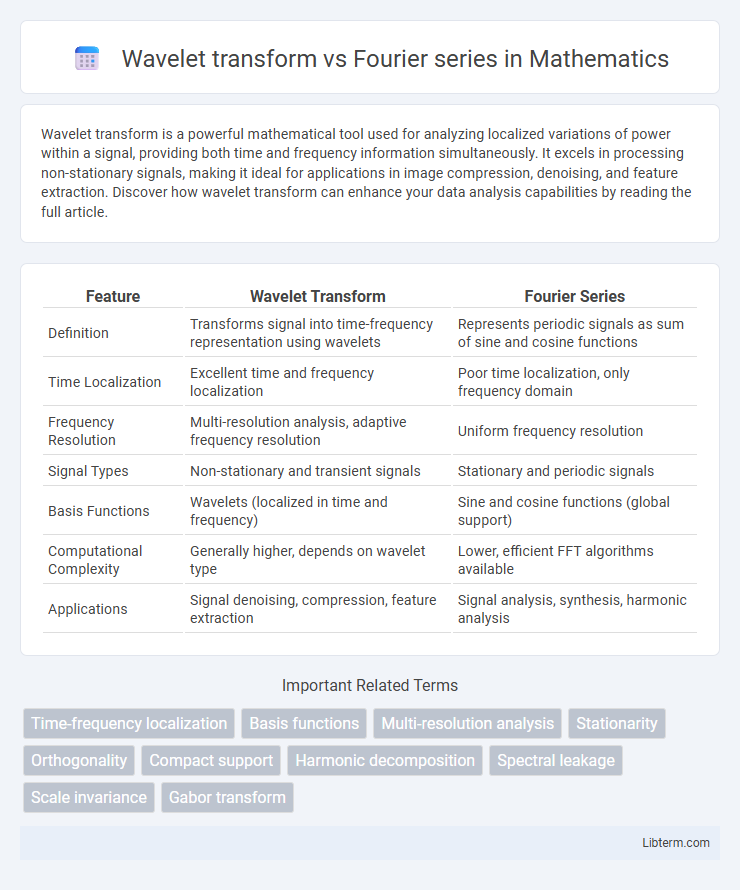Wavelet transform is a powerful mathematical tool used for analyzing localized variations of power within a signal, providing both time and frequency information simultaneously. It excels in processing non-stationary signals, making it ideal for applications in image compression, denoising, and feature extraction. Discover how wavelet transform can enhance your data analysis capabilities by reading the full article.
Table of Comparison
| Feature | Wavelet Transform | Fourier Series |
|---|---|---|
| Definition | Transforms signal into time-frequency representation using wavelets | Represents periodic signals as sum of sine and cosine functions |
| Time Localization | Excellent time and frequency localization | Poor time localization, only frequency domain |
| Frequency Resolution | Multi-resolution analysis, adaptive frequency resolution | Uniform frequency resolution |
| Signal Types | Non-stationary and transient signals | Stationary and periodic signals |
| Basis Functions | Wavelets (localized in time and frequency) | Sine and cosine functions (global support) |
| Computational Complexity | Generally higher, depends on wavelet type | Lower, efficient FFT algorithms available |
| Applications | Signal denoising, compression, feature extraction | Signal analysis, synthesis, harmonic analysis |
Introduction to Signal Analysis
Wavelet transform provides localized time-frequency analysis, making it ideal for non-stationary signals, unlike Fourier series which decomposes signals into infinite sinusoids representing global frequency components. Fourier series excels in analyzing periodic, stationary signals by expressing them as sums of sines and cosines, but lacks time localization for transient features. Wavelet transform uses scalable and translatable basis functions, enabling multi-resolution analysis crucial for detecting signal edges and discontinuities in signal processing.
Understanding Fourier Series
Fourier series decompose periodic signals into sums of sines and cosines, capturing frequency components with infinite-duration basis functions, ideal for analyzing stationary signals. Wavelet transform provides time-frequency localization using finite-duration wavelets, enabling analysis of non-stationary signals with varying frequency content over time. Understanding Fourier series involves recognizing its strength in representing periodic, continuous signals through orthogonal basis functions for spectral analysis.
Fundamentals of Wavelet Transform
The Wavelet Transform fundamentally differs from the Fourier Series by analyzing signals with localized time-frequency representation, enabling the examination of non-stationary signals through variable window sizes. Unlike the Fourier Series, which decomposes a signal into infinite sinusoidal components with fixed frequency resolution, the Wavelet Transform uses scalable and translatable mother wavelets to capture both high-frequency details and low-frequency trends efficiently. This adaptability makes wavelets particularly powerful for applications in signal processing, image compression, and noise reduction, where time-localized information is critical.
Key Differences Between Fourier and Wavelet Methods
Fourier series decompose signals into infinite sums of sines and cosines, providing frequency information but lacking time localization, which limits analysis of non-stationary signals. Wavelet transform uses localized wavelets at multiple scales, offering both time and frequency resolution, making it ideal for transient or time-varying signal analysis. Fourier methods excel in analyzing periodic signals, while wavelets handle abrupt changes and localized features with higher efficiency.
Time-Frequency Localization Capabilities
Wavelet transform provides superior time-frequency localization compared to Fourier series by using scalable and shiftable wavelet functions, enabling detailed analysis of transient signals and localized features. Fourier series decomposes signals into fixed-frequency sinusoids, offering excellent frequency resolution but poor time localization, making it less effective for non-stationary signals. This adaptive time-frequency resolution of wavelet transform makes it ideal for analyzing signals with varying frequency content over time.
Applications in Signal Processing
Wavelet transform excels in analyzing non-stationary signals through time-frequency localization, making it ideal for image compression, denoising, and transient detection in biomedical signals. Fourier series, while effective for periodic and steady-state signals, lacks temporal resolution, limiting its use in applications requiring precise time-based analysis like speech and seismic signal processing. The adaptability of wavelets to various signal scales enhances its applicability in diverse fields including radar, audio processing, and fault diagnosis.
Computational Efficiency Comparison
Wavelet transform offers superior computational efficiency compared to the Fourier series due to its multi-resolution analysis, enabling localized time-frequency representation and reducing the number of required calculations for complex signals. Fourier series, relying on global sine and cosine basis functions, often requires more computational resources to achieve high-resolution frequency analysis, especially for non-stationary signals. Consequently, wavelet transform is preferred in real-time signal processing and large-scale data applications where computational speed and efficiency are critical.
Handling Non-Stationary Signals
Wavelet transform excels in handling non-stationary signals by providing both time and frequency localization, allowing analysis of transient features and sudden changes. Fourier series decompose signals into infinite sums of sinusoids, assuming stationarity and thus struggle with time-varying behaviors. Wavelet's multi-resolution analysis offers superior adaptability for signals with localized, non-periodic components compared to the global, periodic nature inherent in Fourier series.
Advantages and Limitations
Wavelet transform offers better time-frequency localization compared to Fourier series, enabling detailed analysis of non-stationary signals and transient features. Fourier series excels in representing periodic, stationary signals with simpler computations but lacks precision in time-domain resolution for complex signals. Wavelet transform requires higher computational resources and more complex implementation, while Fourier series remains efficient for signals with known frequency components.
Choosing the Right Technique
Wavelet transform excels in analyzing non-stationary signals with localized time-frequency features, offering multi-resolution capabilities that adapt to varying signal scales. Fourier series provides a powerful tool for representing periodic and stationary signals through harmonic components but lacks temporal localization. Selecting the right technique depends on signal characteristics: use wavelet transform for transient or time-varying data and Fourier series for steady-state, periodic signals.
Wavelet transform Infographic

 libterm.com
libterm.com